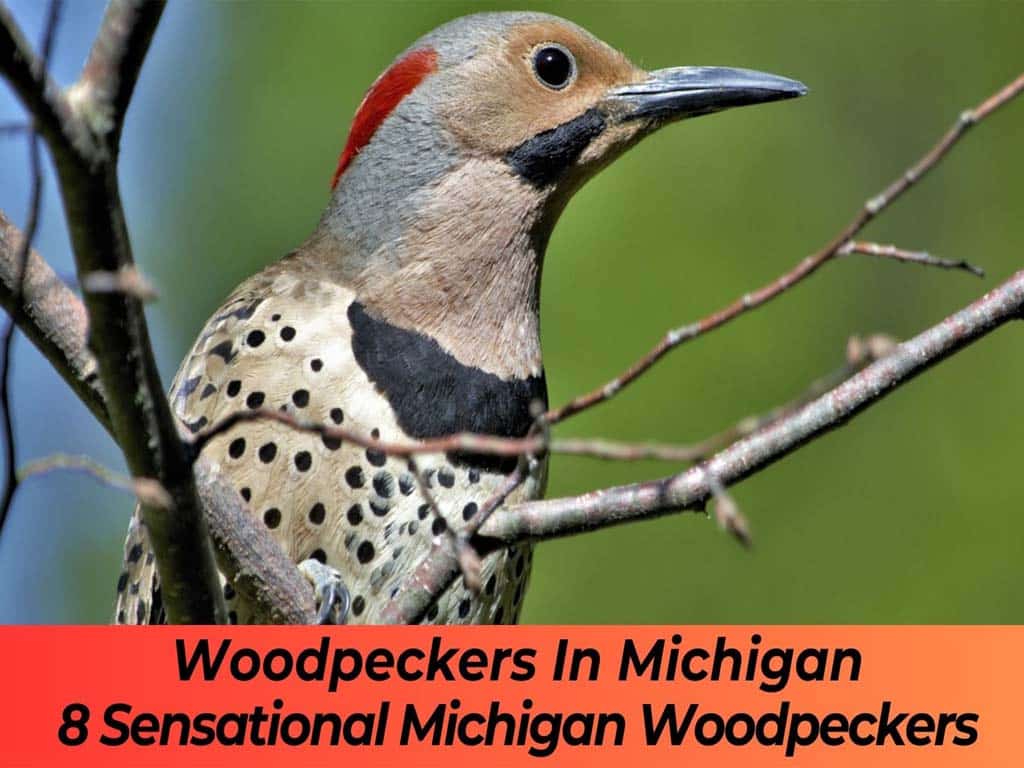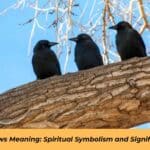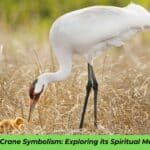Michigan is a veritable treasure trove for birdwatchers, boasting a diverse array of woodpeckers in Michigan that captivate nature enthusiasts from around the state.
These vibrant, energetic birds play a vital role in Michigan’s ecosystems, serving as both predators and prey within the intricate web of life. From the majestic Pileated Woodpecker to the charming Red-bellied Woodpeckers in Michigan, the state’s forests and woodlands resound with their distinctive drumming and calls.
Birdwatchers often seek out these fascinating creatures in Michigan’s numerous state parks and nature reserves, where the woodpeckers can be observed foraging for insects, excavating nesting cavities, and engaging in their unique behaviors.
Whether in the dense forests of the Upper Peninsula or the suburban parks of southern Michigan, these industrious birds contribute significantly to the state’s rich avian diversity and ecological balance.
In this comprehensive guide, we’ll explore 8 of the most sensational woodpecker species found within the Great Lakes State, delving into their unique identities, habitats, behaviors, and conservation statuses.
Whether you’re an avid birder or simply curious about the feathered denizens of Michigan’s forests, this article promises to be a captivating exploration of the state’s woodpecker wonderland.
Woodpeckers In Michigan
Black-backed Woodpecker

The Black-backed Woodpecker is a striking and elusive resident of Michigan’s coniferous and mixed forests, particularly in areas that have recently experienced fire or insect infestations. With its distinctive black back, white belly, and vibrant yellow crown, this species is a true standout among the state’s avian inhabitants.
Identification:
- Solid black back and wings, with a white patch on the lower back
- Underside is predominantly white, with a yellow crown on the male and a plain black crown on the female
- Relatively large size, with a long, chisel-like beak
Habitat and Behavior:
- Favors mature, dense forests with an abundance of dead and dying trees, which serve as a prime source of the wood-boring insects that make up the majority of its diet
- Adept at extracting these insects from the bark and wood using its powerful, spike-like bill
- Known to be somewhat nomadic, following the movements of its prey and often appearing in areas that have recently experienced disturbance
Conservation Status:
- Considered a species of special concern in some regions due to its specialized habitat requirements and sensitivity to forest management practices
- Populations in Michigan appear to be stable, but ongoing monitoring and conservation efforts are crucial to ensure the Black-backed Woodpecker’s long-term survival in the state
Check this out Why Don’t I Hear Mourning Doves Anymore? Reasons
Downy Woodpecker (woodpeckers in michigan)

As Michigan’s smallest woodpecker species, the Downy Woodpecker in Michigan is a common and beloved visitor to backyard feeders and urban green spaces throughout the state. This diminutive dynamo is a true marvel of adaptation, able to cling to the thinnest of branches and extract insects from even the most crevice-filled bark.
Identification:
- Distinguishable by its black-and-white patterned back, white underside, and small stature
- Males have a distinctive red patch on the back of the head, while females have a plain black crown
- Considerably smaller than its close relative, the Hairy Woodpecker, with a shorter, more delicate beak
Habitat and Behavior:
- Highly adaptable, thriving in a variety of woodland habitats, including urban and suburban areas with mature trees
- Often seen foraging on the trunks and branches of trees, as well as making frequent visits to backyard feeders
- Known for its acrobatic abilities, able to cling to the thinnest of branches and even hang upside down while searching for prey
Conservation Status:
- Classified as a species of least concern by the International Union for Conservation of Nature (IUCN), with stable populations throughout its range
- Remains a common and widespread resident in Michigan, benefitting from the state’s abundance of urban and suburban green spaces
Check this out Parrots in Florida – Complete Guide To Wild Parakeets In Florida
Hairy Woodpecker

The Hairy Woodpecker in Michigan is a larger, more robust cousin of the Downy, with a distinct white back stripe and solid black back that sets it apart from its smaller kin. This powerful woodpecker is a fixture in Michigan’s mature forests, parks, and wooded neighborhoods, where it plays a vital role in the ecosystem.
Identification:
- Larger than the Downy Woodpecker, with a more prominent white back stripe and a longer, stronger beak
- Plumage consists of a solid black back, white underside, and a red patch on the male’s head
- Can be distinguished from the similar-looking Downy by its larger size and proportionally longer, chisel-like beak
Habitat and Behavior:
- Typically found in mature, deciduous and mixed forests, as well as parks and wooded urban and suburban areas
- Forages primarily on the trunks and larger branches of trees, using its powerful beak to extract insects and larvae from deep within the wood
- Known for its loud, resonant drumming, which it uses to mark its territory and attract mates
Conservation Status:
- Classified as a species of least concern by the IUCN, with stable populations throughout its range
- Remains a common and widespread resident in Michigan, benefiting from the state’s abundance of mature, wooded habitats
Check this out Why Do Hawks Screech? The Surprising Truth
Northern Flicker

The Northern Flicker is a unique and distinctive woodpecker species found throughout Michigan, known for its habit of foraging on the ground in search of ants and other insects. With its striking brown-and-black plumage and bright yellow or red wing and tail linings, the Flicker is a true standout among the state’s avian residents.
Identification:
- Easily recognized by its brown-and-black speckled plumage, with a distinctive white rump patch that is visible in flight
- Underside of the wings and tail feathers are a vibrant yellow or red, depending on the regional population
- Males have a distinctive black “mustache” marking, while females lack this distinctive feature
Habitat and Behavior:
- Prefers open, park-like woodlands and areas with a mix of trees and open ground, where it can forage for its primary food source: ants
- Unlike other woodpeckers, the Northern Flicker is known for its habit of frequently foraging on the ground, using its long, curved beak to extract ants and other insects from the soil
- Maintains a diverse diet, also feeding on berries, seeds, and even suet at backyard feeders
Conservation Status:
- Classified as a species of least concern by the IUCN, with stable populations throughout its range
- Remains a common and widespread resident in Michigan, benefiting from the state’s abundance of suitable, open woodland habitats
Check this out Finches in Ohio: 9 Ohio Finches (With Photos)
Pileated Woodpecker

The Pileated Woodpecker is the largest woodpecker species found in Michigan, with a striking red crest and powerful, chisel-like beak that allows it to carve out impressive, rectangular-shaped cavities in trees. This majestic bird is a true icon of Michigan’s mature, deciduous and mixed forest habitats.
Identification:
- Unmistakable, with its large size, black-and-white plumage, and distinctive red crest
- Easily recognized in flight by its large, white wing patches and undulating, woodpecker-like flight pattern
- Males have a red “mustache” marking, while females have a plain black face
Habitat and Behavior:
- Primarily found in mature, deciduous and mixed forests, often in areas with an abundance of large, dead or dying trees
- Uses its powerful beak to excavate large, rectangular-shaped cavities in tree trunks, which it uses for nesting and roosting
- Known for its loud, resonant drumming and distinctive, laughing call, which can be heard echoing through the forest
Conservation Status:
- Once greatly diminished in numbers due to habitat loss and hunting, the Pileated Woodpecker has made a remarkable comeback in recent decades
- Currently classified as a species of least concern by the IUCN, with stable populations throughout its range in Michigan and beyond
Check this out Birds With Funny Names – The Complete List of Funny Bird Names
Red-bellied Woodpecker

While the Red-bellied Woodpeckers in Michigan may not be the most aptly named of Michigan’s woodpecker species (its “red belly” is often quite faint), this charismatic bird is a beloved fixture in the state’s wooded urban and suburban areas, regularly visiting backyard feeders and delighting birdwatchers.
Identification:
- Distinctive black-and-white barred back, with a faint reddish wash on the belly that is often difficult to see in the field
- Males have a complete red crown and nape, while females have red only on the nape
- Can be confused with the similar-looking Red-headed Woodpecker, but lacks the latter’s bright red head and neck
Habitat and Behavior:
- Found in a variety of wooded habitats, including urban and suburban areas with mature trees
- Known for its frequent visits to backyard feeders, where it will feast on suet, nuts, and other offerings
- Maintains a diverse diet, feeding on insects, nuts, berries, and even small lizards and nestlings
Conservation Status:
- Classified as a species of least concern by the IUCN, with stable populations throughout its range
- Remains a common and widespread resident in Michigan, benefiting from the state’s abundance of urban and suburban green spaces
Red-headed Woodpecker

The Red-headed Woodpecker is arguably one of the most eye-catching and recognizable avian residents of Michigan, with its unmistakable bright red head, neck, and upper breast. This charismatic species was once a common sight throughout the state, but has experienced population declines in recent decades.
Identification:
- Easily identified by its striking, all-red head and neck, contrasting with a black back and white belly
- Juveniles and non-breeding adults have a mottled brown-and-white plumage, lacking the distinctive red head
Habitat and Behavior:
- Prefers open, park-like woodlands and areas with a mix of trees and open spaces, where it can efficiently forage for its diverse diet of insects, nuts, and berries
- Known for its impressive ability to catch flying insects in the air, as well as its tendency to visit backyard feeders
- Maintains a loud, harsh call that can be heard echoing through its preferred habitats
Conservation Status:
- Once a common resident throughout much of its range, the Red-headed Woodpecker in Michigan has experienced significant population declines in recent decades
- Currently classified as a species of special concern in some regions, due to factors such as habitat loss and competition from other species
- Conservation efforts, such as preserving open, mature woodlands, are crucial to ensuring the long-term survival of this striking Michigan resident
Yellow-bellied Sapsucker

The Yellow-bellied Sapsucker is a unique and fascinating woodpecker species found in Michigan, known for its specialized feeding behavior of creating rows of small holes in tree bark, from which it laps up the flowing sap. This adaptable bird can be found in a variety of forested habitats across the state.
Identification:
- Distinctive black-and-white patterned plumage, with a red crown (males) or forehead (females)
- Underside is a pale yellow color, which gives the species its name
- Can be distinguished from other woodpeckers by its smaller size and the unique row of sap wells it creates on tree trunks
Habitat and Behavior:
- Found in a variety of forested habitats, including both coniferous and deciduous forests
- Uses its sharp beak to create rows of small holes in the bark of trees, from which it laps up the flowing sap and feeds on any insects attracted to the sap
- Maintains a diverse diet, also feeding on insects, berries, and even nectar from flowers
Conservation Status:
- Classified as a species of least concern by the IUCN, with stable populations throughout its range
- Remains a common and widespread resident in Michigan, benefiting from the state’s abundance of suitable forest habitats
Conclusion: Celebrating Woodpeckers in Michigan
Woodpeckers in Michigan are a vital and captivating component of the state’s vibrant avian community, each species adapted to fill a unique niche within the diverse ecosystems found across the Great Lakes State. From the elusive Black-backed Woodpecker to the charismatic Pileated Woodpecker, these remarkable birds continue to captivate birdwatchers and nature enthusiasts alike.
By understanding the unique identities, habitats, and behaviors of Michigan’s woodpeckers, we can better appreciate the crucial role they play in maintaining the health and balance of the state’s forests and urban green spaces. Whether you’re an experienced birder or a casual observer, exploring the wonders of Michigan’s woodpecker species promises to be a truly enriching and enlightening experience.
So, grab your binoculars, venture out into Michigan’s woodlands, and prepare to be amazed by the vibrant, energetic, and fascinating woodpeckers that call this remarkable state home.







